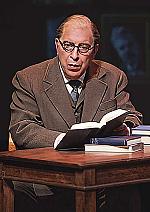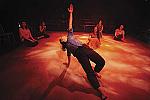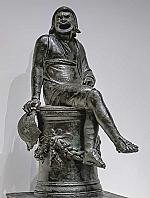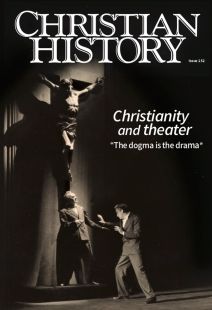“Were you there when they crucified my Lord?”
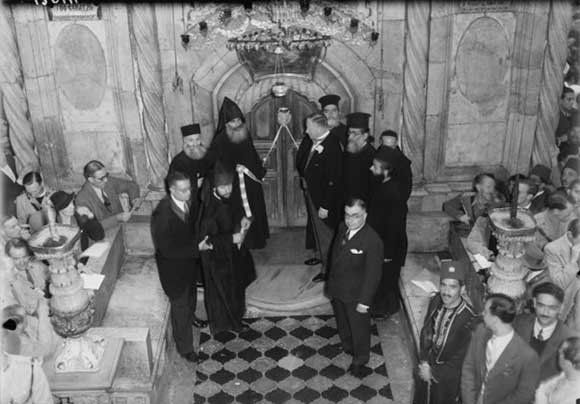
[ABOVE: Calendar of religious ceremonies in Jerusalem, Easter period, 1941. Orthodox Holy Fire--G. Eric and Edith Matson Photograph Collection / Library of Congress no known copyright restrictions.]
Midnight approaches. Darkness shrouds the Orthodox parish. Lamentations for the death of our Lord fill the sanctuary. The chanting ends, from within the altar a single flame appears, and with it the song: “Come receive ye the light from the light that is never overtaken by night. Come glorify Christ risen from the dead.”
From this flame the faithful light their candles, and then all process three times around the church, singing over the pealing church bells, “Thy resurrection O Christ our Savior, the angels in heaven sing.” Before the church doors open, the angel’s proclamation from Mark’s Gospel is read: “He is risen; He is not here.” And following this, the shouted exchange: “Christ is risen!” “Indeed He is risen!”
These actions open the two-hour Pascal Liturgy and close a journey of 70 days from the Sundays leading up to Lent, through Lent itself, and then to Holy Week—a specific cycle followed by the Orthodox Church for at least 1,700 years. Certain details will differ depending on whether you attend a Greek, a Slavic, or a Syrian church, but for each, Holy Week’s multiple services (some 30 hours), the readings, processions, prostrations, and lamentations all focus on God’s work of redemption accomplished in Christ’s Passion 2,000 years ago. It asks the worshipers to enter into that time, that life, that suffering, that grief, not just of Christ, but of those around him who loved, mourned, and even denied him.
SPECTACLE AND DIALOGUE
The term “drama” aptly describes this week. A spectacle, as Christ’s Resurrection “made a spectacle” of the powers of hell. This celebration by mimesis (imitation and representation of physical truth) enters an arc of historical events anticipated since “He shall crush your head, and you will bruise His heel” (Gen. 3:15).
All art—every word uttered and performed—requires of its readers and viewers a dialogue, and the dramatic most of all. The Evangelists crafted narratives to summon a response from their hearers. Their audiences were always hearers, since in the ancient world reading was done aloud and almost always with others. We solemnly observe the momentous days of our lives: weddings, funerals, graduations—marking their importance with rites and conscious actions, with drama. The dramas of the ancient world formed dialogues, not between audience and cast, but within the viewers themselves. Drama, as is often said, demands a response.
Each communion and parish approaches Easter with a different level of solemnity. In the weeks leading up to it, the joy that accompanies the Eucharist is muted. The colors within the sanctuary go from white to purple or dark, indicating a season made sober for repentance. Among Anglicans, Lutherans, Catholics, and Orthodox, Good Friday usually occurs without any Eucharist at all, a day of solemn observance, for on this day the bridegroom has been taken away. On this day his disciples fast. In local Lutheran churches, the banner inscribed with the alleluias processes out of the sanctuary on the Sunday prior to Ash Wednesday. Alleluias, normally sung preceding the reading of the Gospel, have no place, it is held, in the solemnity of Lent. But upon Easter the banner returns.Likewise kneeling throughout Eastertide is forbidden, for Christ has risen, raising us with him into the heavens.
RELIVING TO REMEMBER
Why all of this? Is not the memory that our Lord died, was buried, and rose again enough? But how do we remember? For Christians of past centuries, Christ’s life and Passion constituted the norm that defines and gives meaning to history. To ancients, memory was no mere recollection, but an entrance into events themselves, to be numbered among the mockers and the lamenting women, to weep bitterly with Peter. Through the dramatic, we are pulled into Christ’s journey to Golgotha and his third-day Resurrection. The drama of the liturgy asks us with our whole being—our five senses, our affections, our intellect, and our memory—to imprint Christ’s saving life upon our soul, making it fundamental to our character, to who we are; that is, conforming us to his death that we might attain his Resurrection.
By Cyril Gary Jenkins
[Christian History originally published this article in Christian History Issue #152 in 2024]
Cyril Gary Jenkins, PhD, director of St. Basil Center for Orthodox Thought and Culture and coeditor-in-chief of the center’s journal, Rule of FaithNext articles
Recommended resources: Christianity and theater
Read more about how Christians have participated in, created, and critiqued theater in these resources recommended by our authors and the CH team.
The editors and contributorsSupport us
Christian History Institute (CHI) is a non-profit Pennsylvania corporation founded in 1982. Your donations support the continuation of this ministry
Donate



